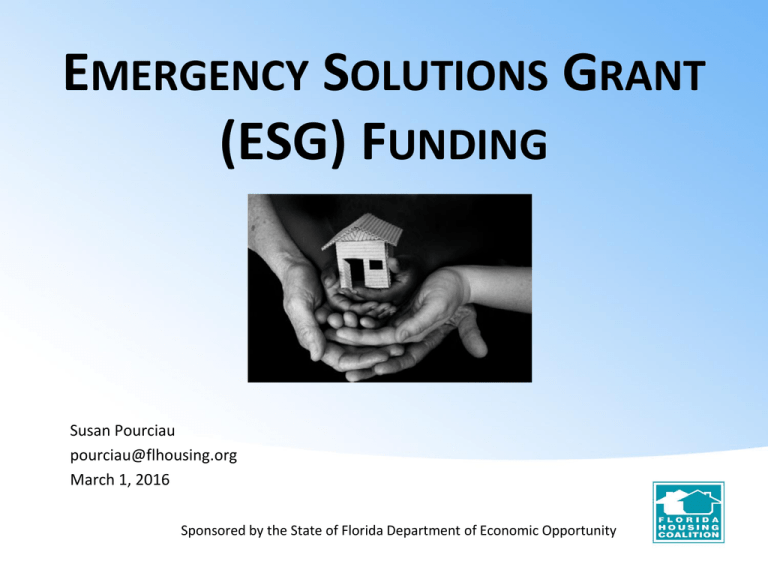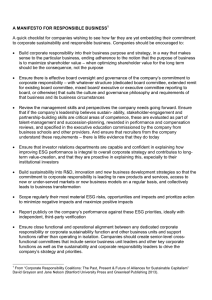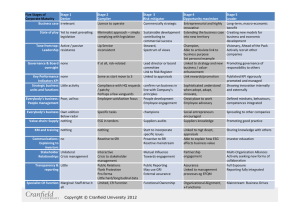PowerPoint - Florida Housing Coalition
advertisement

EMERGENCY SOLUTIONS GRANT (ESG) FUNDING Susan Pourciau pourciau@flhousing.org March 1, 2016 Sponsored by the State of Florida Department of Economic Opportunity WEBINAR LOGISTICS • These slides and a recording of this webinar will be available on our website www.flhousing.org • Participants are muted • Enter your questions in the box in your webinar panel • Handouts are available with this webinar • If you have questions that would be addressed better individually, or you think of questions later, email pourciau@flhousing.org • A survey will follow the webinar; please complete it! OVERVIEW OF WEBINAR • How ESG gets to the local community • How ESG can be used • Who can be served with ESG • Special considerations • What makes ESG work BUT FIRST, SOME QUESTIONS FOR YOU Polls 1, 2, 3 EMERGENCY SOLUTIONS GRANT (ESG) AUTHORITATIVE SOURCES • Emergency Solutions Grant 24 CFR 576* • Continuum of Care Program 24 CFR 578* • HUD Exchange https://www.hudexchange.info/esg/ *To access current federal statutes, visit www.ecfr.gov HOW ESG GETS TO THE LOCAL COMMUNITY ESG is federal funding. HUD provides Emergency Solutions Grant (ESG) funding based on the Federal budget and a formula allocation. Some local governments receive ESG funding as an allocation from HUD. These are “metropolitan cities” and “urban counties.”* Apply through your local government’s process. The State of Florida receives ESG funding as an allocation from HUD. The State process prioritizes communities that do not receive a local allocation. Apply through the DCF Office on Homelessness in a competitive process. Note: This may change if State ESG funds are granted through local CoCs. *To find out which jurisdictions receive ESG funding, and how much, visit https://www.hudexchange.info/grantees/ HOW GOVERNMENT AND THE COC WORK TOGETHER ON ESG FUNDING The ESG Recipient (the government entity that receives the ESG funding initially) is required to work with the local Continuum of Care (CoC) to determine how ESG will be used and evaluated, and CoC-wide ESG Standards. The Recipient must also work with other targeted homeless programs. ESG PROGRAM COMPONENTS 1. 2. 3. 4. 5. Street Outreach – Meet the immediate needs of unsheltered by connecting them with services Emergency Shelter – Provide crisis/temporary housing Homelessness Prevention – Prevent household from moving into homeless assistance system (relocation or stabilization) Rapid Rehousing – Move people out of homelessness into permanent housing HMIS – Recipients’ and subrecipients’ HMIS for the CoC (note: we are not covering this today due to time constraints) Admin (max 7.5%) – planning, training, general management, etc. (may be shared with subrecipient) Limit on emergency shelter and outreach: #1 + #2 may not exceed (but may be less than!) 60% of funding STREET OUTREACH Eligible participant: Person who is homeless and unsheltered. Eligible Activities/Costs: 1. 2. 3. 4. 5. 6. Engagement Case management Emergency health services Emergency mental health services Transportation Services for special populations (e.g., DV) EMERGENCY SHELTER Eligible participant: Person who is homeless and in emergency shelter with no lease or occupancy agreement. Eligible Activities/Costs: 1. Essential services (case management, child care, transportation, legal services, certain mental health services, life skills training, employment assistance, education services, outpatient health services, special populations services, all with limitations) 2. Renovation, rehab, or conversion of shelter facility (note: will trigger 3 or 10 year use requirement) 3. Operating expenses of shelter facility (maintenance, utilities, etc.) 4. Relocation under Uniform Relocation Act if residents are displaced due to the project HOMELESSNESS PREVENTION AND RAPID REHOUSING COMPONENTS Homelessness prevention component helps those who are at risk of homelessness and need relocation and/or stabilization in permanent housing. Rapid rehousing component helps those who are homeless and need relocation and stabilization in permanent housing. The types of assistance (eligible activities) are similar. HOMELESSNESS PREVENTION ELIGIBILITY Household is “at risk of homelessness” as defined in the statute • Annual income below 30% of AMI, determined using HUD income eligibility guidelines, AND • Doesn’t have sufficient resources to prevent them from becoming homeless, AND • Meets ONE of the following: – – – – – – – Moved for economic reasons two or more times in last 60 days Living in someone else’s home due to economic hardship Has written notice that they must vacate within 21 days Lives in a motel not paid for nonprofit or gov’t program Lives in crowded housing (see statute for definition) Exiting public institution or system of care Lives in housing that’s unstable as identified in the local Con Plan. • Certain homeless children and youth (see statute) • Final note: for HP, eligibility must be reassessed every 3 months during assistance ASSISTANCE UNDER HP AND RR 1. Financial assistance* other than ongoing rent a) b) c) d) e) Rent application fees Security deposits Last month’s rent, if required by landlord Utility deposits Utilities in arrears, up to 6 months (is included when counting total number of months of utility assistance, which is limited to 24) f) Moving costs, including up to 3 months storage fees if incurred since assistance began * To third party, not participant ASSISTANCE UNDER HP AND RR (CON’T) 2. Financial assistance for rent a) b) c) d) Limited to 24 months assistance in a 3-year period Recipient has discretion to set caps and limits May pay rental arrears and/or ongoing rent ESG provider must have “Rental Assistance Agreement” with property owner/manager e) Tenant must have written legally binding lease f) FMR and rent reasonableness: Rent must be less than the Fair Market Rent established by HUD, 24 CFR part 888, and comply with HUD's standard of rent reasonableness, 24 CFR 982.507 g) Unit must meet be inspected under lead-based paint requirements and “habitability standards” (see handout) ASSISTANCE UNDER HP AND RR (CON’T) 3. Activities/costs other than financial assistance a) b) c) d) e) Housing search and placement Housing stability case management Mediation Legal services Credit repair SOME REQUIREMENTS FOR ALL ESG PROJECTS • 100% match (cash or in-kind) • Equal access rule for families (no discrimination based on family composition, such as marital status, same-sex partners, etc.) • Prohibition against involuntary family separation. The age of a child under age 18 must not be used as a basis for denying any family's admission to an emergency shelter that uses Emergency Solutions Grant (ESG) funding or services and provides shelter to families with children under age 18 • HMIS & Coordinated Entry • Recipient must file CAPER (Consolidated Annual Performance and Evaluation Report); Subrecipient reporting requirements established by Recipient SOME REQUIREMENTS FOR ALL ESG PROJECTS (CON’T) • Consultation between Recipient and CoC to determine allocation/use of ESG funds, performance measures, project evaluation, and written standards • Documentation and recordkeeping; Eligibility status must be documented in file, using the documentation requirements established by HUD • To terminate a participant from the program, there must be a formal termination process, consistent with statute WHAT MAKES ESG WORK WELL? • Thoughtful resource allocation – For entitlement communities, ensure that the following plans are consistent and developed collaboratively, and that resources match plans: • Consolidated plan and annual action plan, • Local housing assistance plan (LHAP), and • CoC homeless assistance plan (CoCHAP) – For all communities, work with the CoC Board and funding group to ensure that CoC-wide goals are addressed – Avoid: • Conflicts of interest in resource allocation decisions • Doing what we’ve always done because that’s what we’ve always done • Failing to coordinate ESG RR/HP with other RR/HP programs WHAT MAKES ESG WORK WELL? (CON’T) • ESG-funded providers should be high quality professional subgrantees with capacity for grant compliance, HMIS, documentation, matching funds, and programs • Relationships with landlords/ property managers, if doing RR or HP • Avoid requirements that are at odds with best practices (e.g., barriers to assistance) • Use Coordinated Entry and VI-SPDAT or similar tool to match the applicant to the best housing intervention • Use the housing first philosophy • Pay attention to performance outcomes (e.g., not how many were served but how many were housed in PH and stayed housed) • CoC and ESG Recipient must evaluate outcomes http://portal.hud.gov/hudportal/HUD?src=/program_o ffices/administration/hudclips/handbooks/cpd/6509.2 Scroll down to Chapter 28 to access guidelines about ESG WANT TO KNOW MORE? HAVE MORE QUESTIONS? OR WANT A SITE VISIT OR TRAINING IN YOUR COC? Email: pourciau@flhousing.org A list of upcoming webinars, workshops, and trainings is available online at www.flhousing.org





